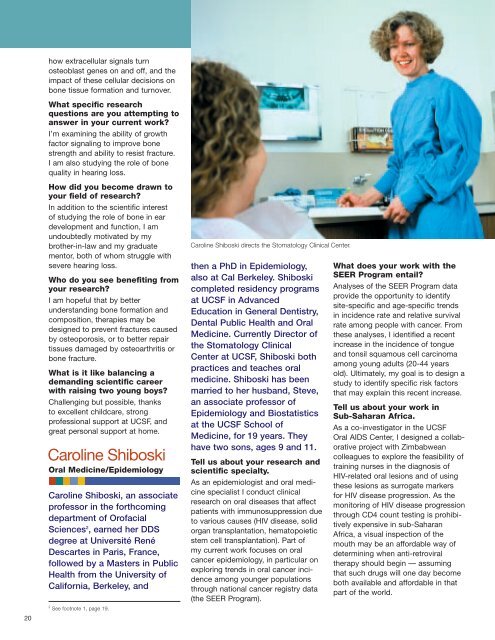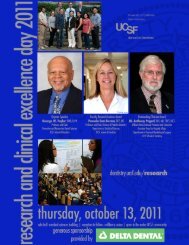magazine - UCSF School of Dentistry - University of California, San ...
magazine - UCSF School of Dentistry - University of California, San ...
magazine - UCSF School of Dentistry - University of California, San ...
You also want an ePaper? Increase the reach of your titles
YUMPU automatically turns print PDFs into web optimized ePapers that Google loves.
20<br />
how extracellular signals turn<br />
osteoblast genes on and <strong>of</strong>f, and the<br />
impact <strong>of</strong> these cellular decisions on<br />
bone tissue formation and turnover.<br />
What specific research<br />
questions are you attempting to<br />
answer in your current work?<br />
I’m examining the ability <strong>of</strong> growth<br />
factor signaling to improve bone<br />
strength and ability to resist fracture.<br />
I am also studying the role <strong>of</strong> bone<br />
quality in hearing loss.<br />
How did you become drawn to<br />
your field <strong>of</strong> research?<br />
In addition to the scientific interest<br />
<strong>of</strong> studying the role <strong>of</strong> bone in ear<br />
development and function, I am<br />
undoubtedly motivated by my<br />
brother-in-law and my graduate<br />
mentor, both <strong>of</strong> whom struggle with<br />
severe hearing loss.<br />
Who do you see benefiting from<br />
your research?<br />
I am hopeful that by better<br />
understanding bone formation and<br />
composition, therapies may be<br />
designed to prevent fractures caused<br />
by osteoporosis, or to better repair<br />
tissues damaged by osteoarthritis or<br />
bone fracture.<br />
What is it like balancing a<br />
demanding scientific career<br />
with raising two young boys?<br />
Challenging but possible, thanks<br />
to excellent childcare, strong<br />
pr<strong>of</strong>essional support at <strong>UCSF</strong>, and<br />
great personal support at home.<br />
Caroline Shiboski<br />
Oral Medicine/Epidemiology<br />
Caroline Shiboski, an associate<br />
pr<strong>of</strong>essor in the forthcoming<br />
department <strong>of</strong> Or<strong>of</strong>acial<br />
Sciences 2 , earned her DDS<br />
degree at Université René<br />
Descartes in Paris, France,<br />
followed by a Masters in Public<br />
Health from the <strong>University</strong> <strong>of</strong><br />
<strong>California</strong>, Berkeley, and<br />
2 See footnote 1, page 19.<br />
Caroline Shiboski directs the Stomatology Clinical Center.<br />
then a PhD in Epidemiology,<br />
also at Cal Berkeley. Shiboski<br />
completed residency programs<br />
at <strong>UCSF</strong> in Advanced<br />
Education in General <strong>Dentistry</strong>,<br />
Dental Public Health and Oral<br />
Medicine. Currently Director <strong>of</strong><br />
the Stomatology Clinical<br />
Center at <strong>UCSF</strong>, Shiboski both<br />
practices and teaches oral<br />
medicine. Shiboski has been<br />
married to her husband, Steve,<br />
an associate pr<strong>of</strong>essor <strong>of</strong><br />
Epidemiology and Biostatistics<br />
at the <strong>UCSF</strong> <strong>School</strong> <strong>of</strong><br />
Medicine, for 19 years. They<br />
have two sons, ages 9 and 11.<br />
Tell us about your research and<br />
scientific specialty.<br />
As an epidemiologist and oral medicine<br />
specialist I conduct clinical<br />
research on oral diseases that affect<br />
patients with immunosuppression due<br />
to various causes (HIV disease, solid<br />
organ transplantation, hematopoietic<br />
stem cell transplantation). Part <strong>of</strong><br />
my current work focuses on oral<br />
cancer epidemiology, in particular on<br />
exploring trends in oral cancer incidence<br />
among younger populations<br />
through national cancer registry data<br />
(the SEER Program).<br />
What does your work with the<br />
SEER Program entail?<br />
Analyses <strong>of</strong> the SEER Program data<br />
provide the opportunity to identify<br />
site-specific and age-specific trends<br />
in incidence rate and relative survival<br />
rate among people with cancer. From<br />
these analyses, I identified a recent<br />
increase in the incidence <strong>of</strong> tongue<br />
and tonsil squamous cell carcinoma<br />
among young adults (20-44 years<br />
old). Ultimately, my goal is to design a<br />
study to identify specific risk factors<br />
that may explain this recent increase.<br />
Tell us about your work in<br />
Sub-Saharan Africa.<br />
As a co-investigator in the <strong>UCSF</strong><br />
Oral AIDS Center, I designed a collaborative<br />
project with Zimbabwean<br />
colleagues to explore the feasibility <strong>of</strong><br />
training nurses in the diagnosis <strong>of</strong><br />
HIV-related oral lesions and <strong>of</strong> using<br />
these lesions as surrogate markers<br />
for HIV disease progression. As the<br />
monitoring <strong>of</strong> HIV disease progression<br />
through CD4 count testing is prohibitively<br />
expensive in sub-Saharan<br />
Africa, a visual inspection <strong>of</strong> the<br />
mouth may be an affordable way <strong>of</strong><br />
determining when anti-retroviral<br />
therapy should begin — assuming<br />
that such drugs will one day become<br />
both available and affordable in that<br />
part <strong>of</strong> the world.




